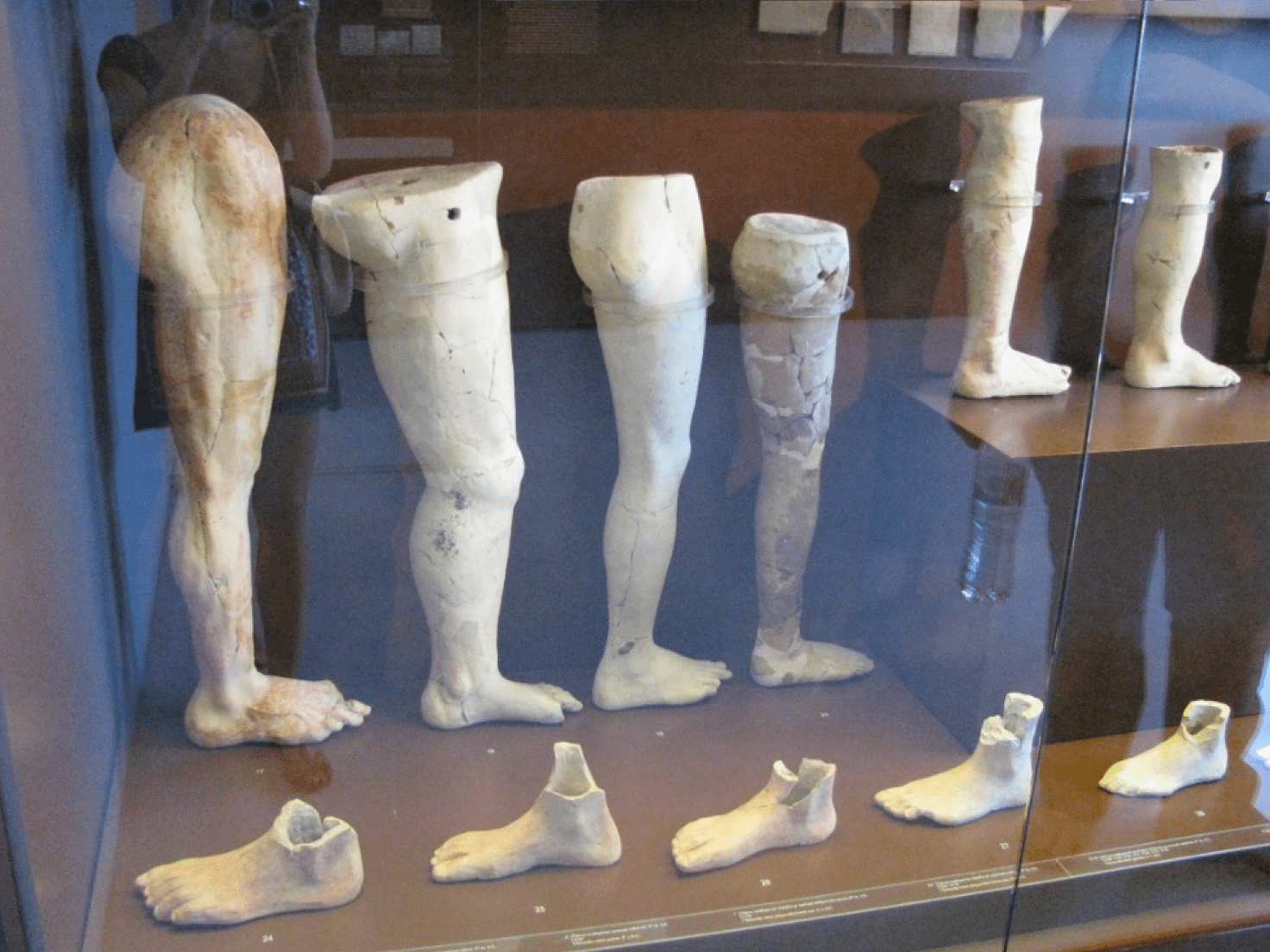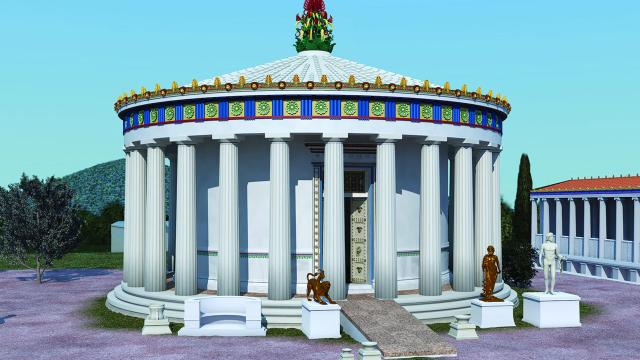Ramps at ancient Greek healing temples provided access for people with disabilities, according to new research. If confirmed, this would be the earliest evidence of a society making architectural adjustments to support accessibility.
Ramps at the entrances of ancient Greek temples are common, but as new research published today in Antiquity argues, some of these ramps, particularly those built at healing sanctuaries, or asclepieia, served as an accessible entrance.
Archaeologist Debby Sneed, the lone author of the new study and a professor at California State University, says these ancient ramps, which are fairly common, have largely been neglected by scholars. After studying the distribution of these ramps at several temples in ancient Greece, Sneed noticed a pattern, namely an increased presence at healing sanctuaries.
“In organising and constructing sanctuaries, [the ancient Greeks] considered the sort of ‘average visitor,’” Sneed told Gizmodo. “At a non-healing sanctuary, your ‘average visitor’ may not have been disabled, but healing sanctuaries specifically attracted people with permanent and temporary disabilities, prolonged illnesses, and other conditions of the body or mind. As such, they built these spaces so that they were accessible to and usable by the people they were specifically built to serve.”

That people living in the ancient Greek world would have a diverse range of mobility is hardly a surprise, as evidence for physical disability dating back to this time period is “overwhelming,” said Sneed. Written accounts from physicians describe a host of conditions related to restricted mobility, while historical texts chronicle many tales of debilitating battlefield injuries. Take Miltiades, for example, the military leader who defeated the Persians at the Battle of Marathon in 490 BC. Miltiades was wounded badly in battle, requiring him to be carried around on a stretcher for the rest of his life. Analysis of human skeletal remains from this time period also shows that many ancient Greek citizens suffered from osteoarthritis.
And then there are less famous people, “like an unnamed 4th century BCE man whom we know from a speech he gave defending himself against a charge of welfare fraud,” said Sneed. “Ancient Athens had a disability pension system — if you were disabled and couldn’t work as a result of your disability, you were entitled to maintenance from the city.” This man, who walked with the aid of two crutches, was accused of not needing the disability pension, but he claimed differently during his speech, according to Sneed. Clearly, ableism has deep roots.
Sneed gathered other evidence showing that two healing temples, one at Epidauros and one at Corinth, likely attracted individuals who experienced challenges with mobility.
The Sanctuary of Asclepius at Epidauros — a very important healing temple built in the 6th century BCE and significantly upgraded after 370 BCE — was a place to worship Asclepius, the god of healing and medicine. Here, Sneed counted 11 stone ramps installed on nine different structures. A similar thing was seen at the smaller Sanctuary of Asclepius at Corinth, which is also associated with Asclepius.
At the Sanctuary in Corinth, and also at some healing sanctuaries in South Italy, archaeologists have uncovered dedications of body parts, known as anatomical votives, which Sneed took as further evidence that people visiting these facilities had mobility issues.

“Visitors would dedicate a representation of the body part they wanted healing,” said Sneed. “We have a lot of legs and feet, ears, and shoulders, but also things like uteruses, brains, and livers.”
The ramps, she said, made it easier for people who had disabilities to visit these sites and make their votive offerings, among other activities performed inside these sanctuaries.
The ramps at these temples could’ve been used for any number of purposes, such as delivering supplies into the temples by cart, but Sneed said they were purposely built with accessibility in mind and that other uses were a bonus.
“When classicists discuss these ramps, they explain them as a means of conveying sacrificial animals, statues, and other dedications, or building materials — and it’s true, we can’t rule those additional uses out,” said Sneed. “This is the idea behind Universal Design (UD) in modern architecture, that you build things that will benefit the most numbers of people. I think that the ramps, especially at healing sanctuaries, were built with disabled people in mind, but they would have been multifunctional.”
To which she added: “Ramps are expensive to build, they require time and materials, but also space because they stick out. The fact that there are so many at healing sanctuaries is significant and requires explanation, which is what I provide in my article.”
Alessandro Pierattini, an assistant professor from the School of Architecture at the University of Notre Dame who wasn’t involved with the new study, said the new paper was “interesting,” and it “raises points that archaeologists have overlooked.” He said Sneed presented a “plausible hypothesis that needs further study.”
One concern Pierattini had with the paper, he said, was that Sneed didn’t provide enough evidence to show that ramps were typical at other healing sanctuaries, of which there are hundreds.
The “whole sample of known asclepieia should have been examined and compared to other sanctuaries,” he said. Also, “more case studies should be examined in order to demonstrate that there were patterns linking the percentage of legs in the votives to the presence of ramps.”
Sneed said the “quantification of ramps is hard,” but she did provide one comparison: the Sanctuary of Zeus at Olympia to the aforementioned Sanctuary of Asclepius at Epidaurus — both large, important, and Panhellenic sanctuaries. The Sanctuary of Zeus at Olympia featured two ramps, “but really just one into a building, the main Temple of Zeus,” she said, as compared to the 11 ramps at the Sanctuary of Asclepius at Epidaurus, which provided access to nine separate structures.
Pierattini also said Sneed was too quick to dismiss the possibility that ramps provided general access to temples, as he wrote to Gizmodo:
The author justly claims that those ramps did not serve for construction or for carrying large votives into temples or treasury buildings. But she does not consider that ramps would have been helpful (or necessary) to carry items that needed to be moved in and out of the temple on a regular basis. According to literary sources, several Archaic communities across Greece carried portable statues of the Gods in procession on festival days. Ramps are found in non-asclepios temples in the Archaic period…Therefore, we cannot exclude that ramps could serve primarily for carrying statues or other paraphernalia in procession, or even to carry provisions (oil, wine, grains, etc) for the ritual banquets that ensued. These banquets were often held in the open air, but several temples are known to have served as storage for provisions, in addition to housing statues, votives, and other ritual objects.
Pierattini certainly brings up some valid and interesting concerns, but Sneed is raising some very important questions about these architectural features, and historical disability issues in general, that warrant further consideration. Indeed, by applying a social model of disability, Sneed presents a welcome challenge to more conventional approaches.
“These ramps have been known about since we’ve known about Greek temples and sanctuaries. They weren’t hidden, I didn’t have to uncover them — I just had to ask different questions,” Sneed told Gizmodo. “Diversity in academia is important because we need people who — by virtue of the fact that they have different lives — will ask new and different questions of the material of the past and, indeed, it is our responsibility to recruit and invest in people who will do just that.”
To which she added: “We need to make our own spaces accessible and welcoming, because if we don’t, we are signalling who we think does and doesn’t belong.”
